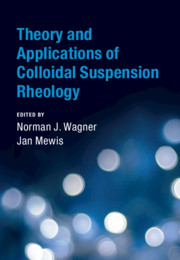
What inspired this book?
Colloidal suspension rheology continues to be among the most active areas of research in the field of soft matter as evidenced from the literature and among the most subscribed topical area at conferences world-wide. Furthermore, the wide-ranging benefits from its industrial application as well as the emerging challenges that span so many disciplines of science and technology merit further exploration of the topic. In our 2012 book, we provided the first foundational treatise of the science of colloidal suspension rheology (Rheology of Colloidal Suspensions, CUP 2012). It brought together in one volume the different aspects of the field, and as such was well received. Obvious limitations of size made it necessary to be selective in topics and keep the discussions concise. As a result, we felt that, to provide a comprehensive basis for those entering the field or an up-to-date reference for those working in the field, it would be important to provide more insight in the underlying theoretical, simulation and experimental methods as well as to elaborate on relevant, additional systems and applications, including biological as well as soft matter. This is the purpose of the present book.
What do you hope will be the lasting impact of this book?
Our goals included working collectively with international experts and leaders in the field to define the central, immutable tenets of each topical area and explain them in a coherent and systematic treatise using the best data, theory and simulation results. Thus, this book will provide an efficient and comprehensive basis to deal with rheological challenges involving colloidal suspensions in academia as well as industrial research and development, formulation and production environments.
Can you share any interesting anecdotes from the book?
We took eight years to write the 2012 book and recognized that we had developed much too much material for a single book. So, already at that time we implicitly agreed to write a second book. After a suitable (recovery) time and good discussions of the value and content of a second book with many in the community, we (wisely) decided that this one would be completed in a much shorter time if we enlisted the help and guidance of the world’s experts in the various topics we wished to cover. Much to our pleasant surprise, our colleagues were very enthusiastic, supportive, and ultimately willing to take on the challenge of working together to create this unique and valuable treatise, and on a (more) reasonable time frame!
Why is your book important?
The present volume, together with the 2012 book, provide a self-consistent and integrated description of colloidal suspension rheology. It provides the necessary background in the various disciplines on which colloid rheology is based. In selecting material to include, we strived to identify proven knowledge, appropriately referenced, while also identifying knowledge gaps as well as future trends where developments are likely. This fundamental knowledge is supplemented by demonstrating how it can be applied in real life applications. To achieve this purpose the present book was written in collaboration with world-experts as co-authors. The editors have closely worked with these co-authors to ensure that the chapters are integrated in a consistent, global text with the 2012 book, thus providing an efficient means to study the field.
Who is the primary audience for the book?
The two volumes provide a self-consistent framework for those who start studying colloidal suspension rheology, either to perform academic research in the subject or to apply this knowledge in one of the various applications. The latter could be product development or solving engineering problems involving flow problems in various industries. Applications are not only found in industry, as illustrated by sections dealing with blood, biological colloids and geological flows. These two volumes also remain a useful reference basis for those already active in the field, with over a thousand important references explained and organized thematically.
Based on your previous answer to the primary audience of the book, what are the market needs/key challenges this audience faces?
Colloid rheology spans an ever-broadening range of disciplines and has a long and distinguished history. Prior to the 2012 treatise, there was no coherent, comprehensive book dedicated to this subject. Therefore, it was challenging for a single researcher to fully appreciate and benefit from the relevance of contributions coming from so many different disciplines.
Does your book solve this need/challenge? How?
This book addresses the need for a systematic, coherent and comprehensive, up-to-date knowledge base for colloidal suspension rheology. This treatise systematically presents and explains advances made in the theory, simulations and applications that we were not able to include in the 2012 book due to space limitations. By thus assembling contributions to the field coming from a wide variety of disciplines, this book provides a valuable guide to the established knowledge in the field, as well as a basis for future advances
What unique features do you think make the book stand out in the market?
This book stands unique in the discipline. It covers the state-of-the-art in the field, explaining theory, simulation and experimental methods including new advances. It also illustrates the wide range of its possible applications. Researchers and practitioners alike will benefit from the coherent and comprehensive presentation of modern methods and advances in the discipline that have been organized and vetted by world-renowned experts, along with a bibliography of the most important published contributions.

Latest Comments
Have your say!